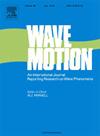Rayleigh wave dispersion and attenuation characterized by couple-stress-based poroelasticity
IF 2.5
3区 物理与天体物理
Q2 ACOUSTICS
引用次数: 0
Abstract
In this paper, propagation of Rayleigh waves in a fluid-saturated porous solid is studied by using the couple-stress-based gradient theory, which incorporates the rotation gradient, and its work-conjugate counterpart, the couple-stress. In the frequency domain, wave equations involving a length parameter , that characterizes the microstructure of the material, are derived and, by using displacement potentials, coupled wave equations are reduced to four uncoupled wave equations governing the motions of -, -, -, and -waves. Based on the solutions of these equations, the dispersion equation for Rayleigh waves is obtained. Numerical results show that Rayleigh waves are dispersive at all frequencies in the range considered, unlike the velocity dispersion characterized by the classical theory, and the wave velocity is always higher than the conventional Rayleigh wave velocity. It is shown that the attenuation decreases as increases. The effects of porosity, the ratio of bulk modulus of the solid skeleton to the solid phase, and the length parameter on Rayleigh wave dispersion and attenuation are also investigated.
基于耦合应力的孔隙弹性瑞利波频散与衰减特征
本文采用基于耦合应力的梯度理论研究了瑞利波在流体饱和多孔固体中的传播,该理论结合了旋转梯度和功共轭梯度,即耦合应力。在频域,导出了包含表征材料微观结构特征的长度参数的波动方程,并利用位移势将耦合波动方程简化为控制P1-, P2-, SV-和sh -波运动的四个不耦合波动方程。根据这些方程的解,得到了瑞利波的色散方程。数值结果表明,在考虑的范围内,瑞利波在所有频率上都是频散的,而不是经典理论所描述的速度频散,并且波速总是高于传统瑞利波速。结果表明,衰减随衰减系数的增大而减小。研究了孔隙率、骨架体积模量与固相之比以及长度参数对瑞利波色散和衰减的影响。
本文章由计算机程序翻译,如有差异,请以英文原文为准。
求助全文
约1分钟内获得全文
求助全文
来源期刊

Wave Motion
物理-力学
CiteScore
4.10
自引率
8.30%
发文量
118
审稿时长
3 months
期刊介绍:
Wave Motion is devoted to the cross fertilization of ideas, and to stimulating interaction between workers in various research areas in which wave propagation phenomena play a dominant role. The description and analysis of wave propagation phenomena provides a unifying thread connecting diverse areas of engineering and the physical sciences such as acoustics, optics, geophysics, seismology, electromagnetic theory, solid and fluid mechanics.
The journal publishes papers on analytical, numerical and experimental methods. Papers that address fundamentally new topics in wave phenomena or develop wave propagation methods for solving direct and inverse problems are of interest to the journal.
 求助内容:
求助内容: 应助结果提醒方式:
应助结果提醒方式:


